In early 1992, Compaq released their last “luggable / portable” computer, the Compaq Portable 486, marking the end of an era.

Background
The Compaq Portable 486 was the last portable computer in Compaq’s original “Compaq Portable” line. By the time of its release in 1992, Compaq and other portable manufacturers knew that the days of the portable/luggable were numbered. This news was not new – portable sales had been declining with luggables fighting a losing battle as most people flocked to the much more portable and increasingly more powerful laptops.
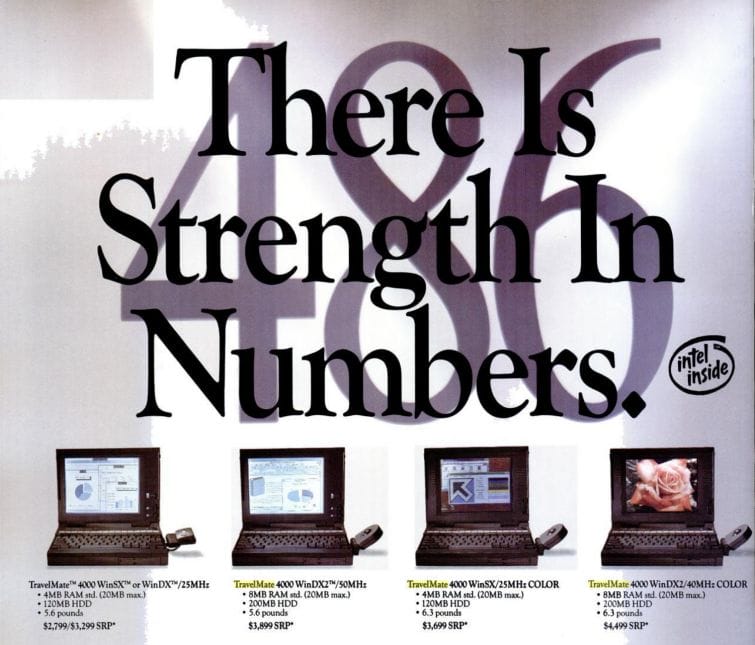
Prior to 1992, laptops were significantly underpowered compared to luggable portables (and desktops). Still, by the mid-1990s, as computer development accelerated, the performance & price gap between laptops and portables had disappeared. The rationale to carry an 18 LBs. sewing box-style computer also vanished. Compaq Portable 486’s made after this time were relegated to more specialized use cases, such as being a network sniffer.


This is not to say that the rise of laptops took Compaq by surprise at all – Compaq knew laptops would be the wave of the future. However, they were late to the market, as they refused to follow the competition and release a more basic laptop. Though this “wait and over-deliver” strategy paid off – in 1988, they finally gave in and released the Compaq SLT/286, Compaq’s first laptop computer that was a commercial success.

The End of the Luggable
As the 1990s progressed, laptops continued to get more and more powerful, and battery life improved. This article below from 1993 foresaw the future where the “luggable” portable computer would be transformed into a niche product, if not disappear altogether.

And whilst luggables did pretty much disappear, the last Compaq Portable, the Compaq Portable 486, did find a small niche.
Specific use cases were definitely there; for example, to give multimedia presentations on-the-go – as video & sound presentations need large, bright, (and power-hungry) displays with accompanying speakers. People looking for portable, true desktop-class power with full-length ISA / EISA card expandability found that the Compaq Portable 486 would fit the bill.

Don’t forget, back in 1992, expansion slots were necessary to add digital sound functionality through sound cards. Most laptops did not have sound cards until 1994. A whole slew of other applications that required specialized ISA / EISA cards, such as for computer networking or hooking up scientific instruments, would have required a portable or a desktop if the computer did not need to be moved.

As you can see, this computer is a bit of an oddity. It was the last of it’s kind and seemed to struggle slightly with an identity crisis. Everyone, including Compaq, knew this would be the last “computer with a handle” they would make. Compaq approached this computer with a 2-in-1 approach of “portable desktop” than other previous portable luggables. There is a clear emphasis on performance and display technology, making the Compaq Portable 486 comparable to mid-to-high-end desktops of its release year. In fact, this computer goes beyond a traditional desktop of its time and replaces the CRT with a state of the art LCD – likely a significant contributing factor to its high price. It is, however, a bit disappointing that the LCD does not support SVGA.
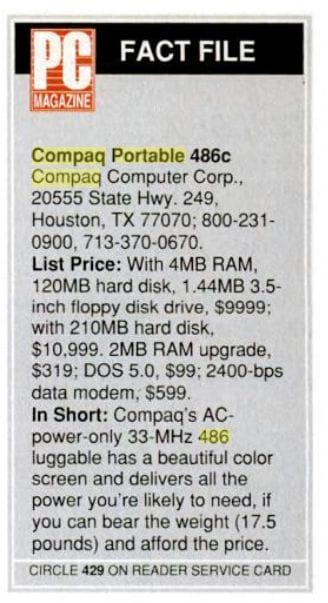

First Portable Vs. Last Portable
Here’s how the last Compaq Portable and the first Compaq Portable stack up against each other. It’s amazing how far computer technology advanced in 10 (or so) years:

Compaq Portable 486 (My modified version is above, factory specs below:)
Year: 1992
CPU: 486DX2 @ 33 Mhz (socketed / upgradeable to AMD 5×86 133 MHz)
Max RAM: 32 MB (Comes with 4MB stock)
Video / Display: VGA Active Matrix TFT LCD with 256 Colors @ 640 x 480
Hard Disk: 210 MB (IDE)
Floppy Disk: 1x 3.5” Floppy
Expansion Bus: 2x EISA
Connectors: PS/2 Keyboard, Mouse, SCSI, Parallel, Serial, External VGA, Audio Input, Power
Weight: 17.4 Lbs / 7.9 KG
Units Shipped in First Year: Several Thousand
Price: $10,999 ($20,128 in 2019)
VS.

Compaq Portable
Year: 1982
CPU: 8088 @ 4.7 MHz
Max RAM: 640K (Comes with 128K stock)
Video / Display: Emulated MDA / CGA on 9” Green Phosphor CRT
Hard Disk: None
Floppy Disk: 2x 5.25 Floppy
Expansion Bus: ISA (?)
Connectors: Parallel, Serial, Power
Weight: 34 Lbs / 15.4 KG
Units Shipped in First Year: 53,000
Price: $3,590 ($9,551 in 2019)
A Closer Look at the Comapaq Portable 486
Looking at the comparison above, the most obvious thing that stands out is the price of the Compaq Portable 486 (it’s another one of Compaq’s computers that cost the same price as a car at release, like the Compaq Portable 386). Though, if you take a closer look at the specs and see that for 1992, it’s a mighty computer – packing a decently clocked 486 with up to 32 MB (!!) of RAM.

Weighing in at 17 lbs, the Compaq Portable 486 was relatively light, retaining the lunchbox/suitcase form factor (with the keyboard folding up to lock over the screen), a feature that echoes throughout the design of all Compaq Portables. The Compaq Portable 486 line was the only Compaq Portable to be offered with a color screen (Model 486c – the alternate non “C” model was a monochrome TFT). It also came in 2, 486-CPU varieties, a 33 Mhz, and 66 Mhz, the latter marketed as 486/66 or 486/66c. Both variants were socketed and easily upgradeable.

The Compaq Portable 486 came stock with 4MB of RAM but could be expanded to accommodate up to 32 MB of RAM, the largest amount of RAM in any portable at the time. 32 MB of RAM in 1992 is excessive. Perhaps this RAM expandability coupled with the socketed 486 CPU was a selling point of “future-proofing” the computer to justify its relatively high price. The socketed CPU and support for a large amount of RAM meant that, when maxed out with 32 MB of RAM and an AMD 5×86 CPU running at 133 MHz, the Portable 486 can run Windows 98 (albeit a bit slowly) – but is very responsive in Windows 95.

The Active Matrix TFT LCD screen was and still is impressive – the first thing you notice about it is how bright it is (at the max setting, you get immediate eye strain). Thankfully the brightness can be dialed down through the brightness dial on the right of the display panel. The screen is backlit with a compact TFL bulb, the shape of which causes a slight shadow on-screen but is not too noticeable. I’m sure in 1992, it was a non-issue since LED backlighting was still 10 years away.
The color Active Matrix TFT screen made up a significant portion of the unit’s cost, as the technology was brand new at the time (in 1993, an external consumer flat panel TFT active matrix display cost $1,600 – $2,000). It really does suck, though, that the internal video card is not SVGA compatible. I guess you could work around this by using an external monitor and an ISA / EISA video card, but then that sort of defies the purpose of having a Compaq Portable 486.

Built In Speakers
Another neat thing about the Compaq Portable 486 was that it featured an audio input jack that allows you to feed the output of an audio card into it, which piped out the sound through its relatively large but mono internal speaker. This meant that you did not have to carry speakers around with you, as mentioned in the ad snipped above, highlighting the benefits of this computer for use in giving mobile presentations on the go.

The benefit of this speaker configuration is that today, this computer makes a great “mid-MS-DOS era” computer for games such as Doom, Duke Nukem, Wacky Wheels, etc., and other early Windows games that didn’t need more than 256 colors like SimTower or Command & Conquer. As it’s an all in one, so, once you have had your gaming “fix,” you can simply fold the keyboard up and stow the computer away. The only accessory you need to put in a drawer somewhere is a mouse.

Next Post: Booting & Setup of the Compaq Portable 486 >>>
Or check out other posts that might interest you:
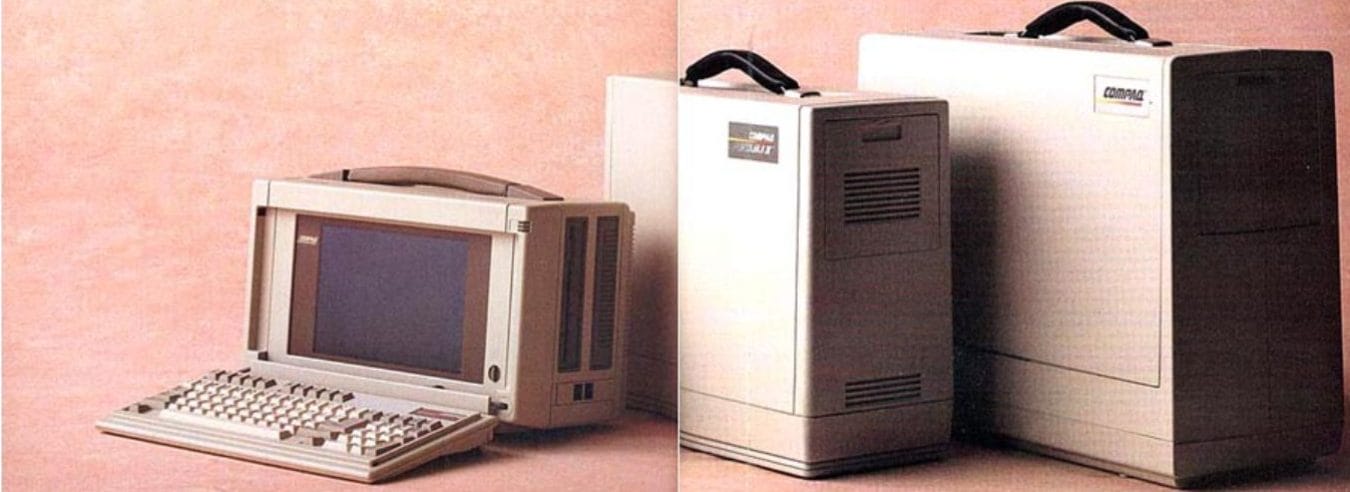

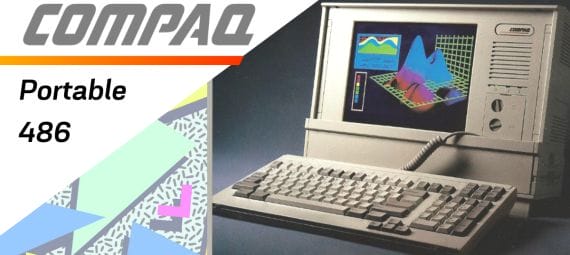
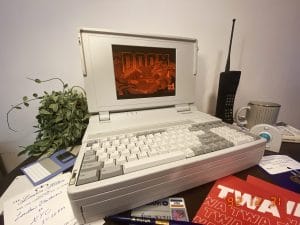
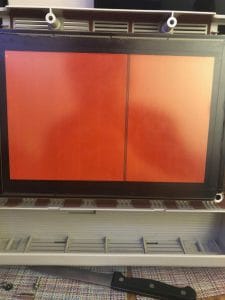
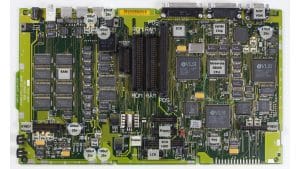
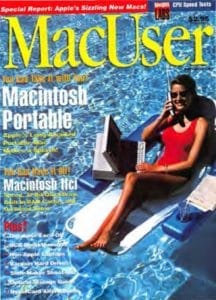
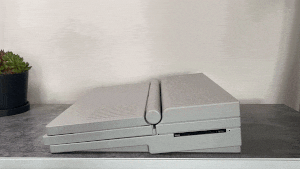
Any known supplier for parts for a 486c. I just purchased one on ebay and appears I need a power supply.
Probably eBay – the did not make too many of these and any parts suppplier from back in the day won’t stock these parts in 2020
I have just dragged my old one of these out the loft and it seems to be working. It is the monochrome version and I wondered if you knew of any dedicated collectors?
Hi There, sorry I didn’t see this message – do you still have it?
Hello,
I’m trying to collect the model information about these computers. Will you assist me? I think on the bottom of the 486 computers, there should be a label that shows the “Series” the machine belongs to. The Portable 386 was 2670, and the SLT/LTE machines later took 2680/2690.
Hi there sorry my unit is in storage at the moment, maybe someone who sees this can help
Daniel the bottom of (my) Compaq Portable 486c/66 displays “Series 2713” “FCC ID: CNT75MA99” on the bottom of the unit. Thank You retropaq for an excellent article write-up.
I’m hoping to build a 3D printed replica of the Compaq Portable 486c, using either a Raspberry Pi or LattePanda board. It’d REALLY help to have dimensioned drawings since I don’t have an actual PC. Can anyone help?
Thanks, David
Hi David, just out of curiosity, how would you get the measurements if you had the machine?